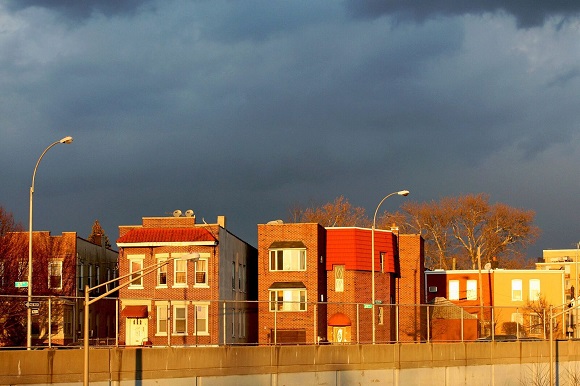Judy Marrocco was back in town. She’d been recalled here, where she’d spent her early years, for her great-aunt Henrietta had recently died, leaving Judy – her only surviving kin — the old house near Mt. Olivet Cemetery. The news came at a crossroad in the young woman’s life. She had nearly completed her degree at the Pennsylvania Academy of the Fine Arts in Philadelphia, and as graduation approached, her dream for the immediate future seemed to be evaporating as quickly as those of her nighttime slumbers.
The dream was, in fact, an old one: to move to Paris, or Rome, or perhaps to the south of France – where the special quality of light had inspired so many great artists to create their masterpieces – and spend the rest of her life there as a painter. But now that it was time to set it in motion, she found that she lacked the necessary funds. Her parents were deceased; she’d won a scholarship to the prestigious art school but that money was nearly gone.
In the end, she decided that the call from Maspeth, a place she hadn’t re-visited in fifteen years, might indeed be a case of kismet. She would return and have a look at the old house with the idea of staying there a year – only one year, she promised herself – until her dream plan had time to crystallize.
The house was on Brown Place, half-way between the cemetery and the service road to the Expressway. When Judy arrived, she had to marvel at it. Really, Aunt Henrietta was a wonder to have kept it in such excellent condition! But there was something else about it: Every room, every nook of it, not to mention the beautifully painted exterior with its gaily colored pillars, told her that this had been a well-loved, not just a well-tended home. She could picture her aunt in a rocking chair on the veranda, enjoying good weather, reading a book, perhaps with a cat on her lap, or chatting with neighbors.
“I will definitely stay here!” she told the person showing her the house, while to herself she said: I’ll keep things here just as they are, adding only my library of art books, my paints, and clothing. And once I’m settled in, I’ll take long walks in the morning or early evenings, whenever the light is just right!
Judy lived for such times. When she was seven, her art class in school had been treated to a visit to the Metropolitan Museum of Art. Standing before a painting by Vermeer, she remembered, even now, asking, “Where does the light come from?”
“The window, silly!” answered Joey Dowell, the know-it-all classmate who was pointing out to her the painted window above the painted seated figure.
This is not, however, what she meant. She had been asking in an inchoate way how paint applied to canvas can create for the viewer the illusion of an incandescent glow. “But where does the paint-light’ come from?” she tried again, this time looking for the answer from their art class teacher, standing near them. But an enigmatic smile was all that she received from Mr. Groell by way of reply.
Since then, she had been obsessed with the nature of light and how to capture its magic. She had studied the work of the great artists and she had painted a great deal. But she was still nowhere near solving the mystery of where the ‘paint-light’ came from, as she had put it when still a child.
*
By the end of June, she was fully moved in. Realizing she would need at least a part-time job to pay for her necessities, she presented herself one day at The Enchanted Florist on Grand Avenue, explaining to the proprietor that she would, in addition to working behind the counter, present him with still-lifes which he could exhibit and sell in the shop. To her great surprise, he warmly welcomed the suggestion. “Irises,” he sang out to her as she was heading for the door. “I love irises!”
“Irises you shall have then! In abundance!” she answered, laughing.
She did not have to be at The Enchanted Florist before noon on the weekdays, so she spent her mornings, regardless of the weather, walking. Sometimes it was along the paths of the beautiful garden cemetery of Mt. Olivet. Here she would often sit on a bench, take out the sketchpad and watercolors she always carried in her knapsack, and sketch flowers, trees, birds, the play of sunlight on the old tombstones dating back to the 1700s.
Other times she would stroll along Grand Avenue, doing small errands along the way. Whenever the occasion presented itself, she made quick charcoal sketches of the people she met, offering them the finished portraits as gifts. Children were her specialty and whenever they saw her, they came begging her to draw them.
She became a familiar sight, in summer wearing a straw hat evoking the French countryside, in winter bundled to the hilt, in the rain splashing about under a multicolored umbrella. “Hey, Judy!” children and old people alike would greet her wherever she went.
With sketchbook always at the ready, she’d wander about, delighted by the often strange and wondrous sights that Maspeth had to offer: a house where the sunflowers, hinting at the beanstalk of fairytale fame, reached higher than the front door; a giant, but genial-looking blue monster with pink-striped tentacles and bulging eyes standing quietly among the hedges; in the spring, a moose sporting a red Christmas ball on one of his antlers peering out at her from behind a fence!
One winter’s morning following an ice storm, she turned onto a block to discover that the rising sun had transformed it into a sepia-tinted world. It’s like being inside a real-life photograph from an old album, she thought. Virtual reality turned on its head! She returned home eagerly that morning to paint the preternatural vision. But she was unhappy with the finished work: She had not captured the otherworldly light.
A few months later, she was on her way home when dark, threatening storm clouds filled the sky. But in the west, the setting sun was not to be undone. It continued to gild the houses across the Long Island Expressway, setting windows and doors ablaze with glittering gold, painting the bricks and mortar of the buildings bright saffron. Though Judy had strolled here dozens of time, the scene suddenly appeared wholly unfamiliar. She thought: It’s as if an artist-magician had waved his wand and all the houses disappeared – only to reappear in the building style of another country!
And all the while, the heavens were darkening. A gilded city meeting a raven sky: That is what Judy saw. A preview of Ragnarök! she thought – this world about to end as the new one waits in the wings to make its debut. Dazzled, she wanted to store the scene in her memory so as to savor it again and again. All too soon, though, the sun dipped behind the horizon, the dark clouds dispersed and Judy continued on her way. The magic show was over.
Back in the house, she immediately began to paint. She knew she might not succeed in capturing the phantasmal light she had just witnessed, but the effort made her feel gloriously alive. It always did.
As she worked, she told herself, I’ve come back to a good place! And that thought sparked another: she would abandon her plans to move to one of the beauty spots of Europe, would instead remain here to make her life in Maspeth, finding daily inspiration in its streets, its buildings, in the luminous faces of the children who greeted her, in the visual surprises that seemed to lurk around every corner. With these things, she would, in the words of Hermann Hesse, “… weave a bright necklace of pleasures for [her] life.” She smiled as she worked. “I’ve come home!” she shouted, surprising herself.
And though it was surely only a breeze wafting in through the open window, it was as if the old house, hearing her words, heaved a deep sigh of relief …




